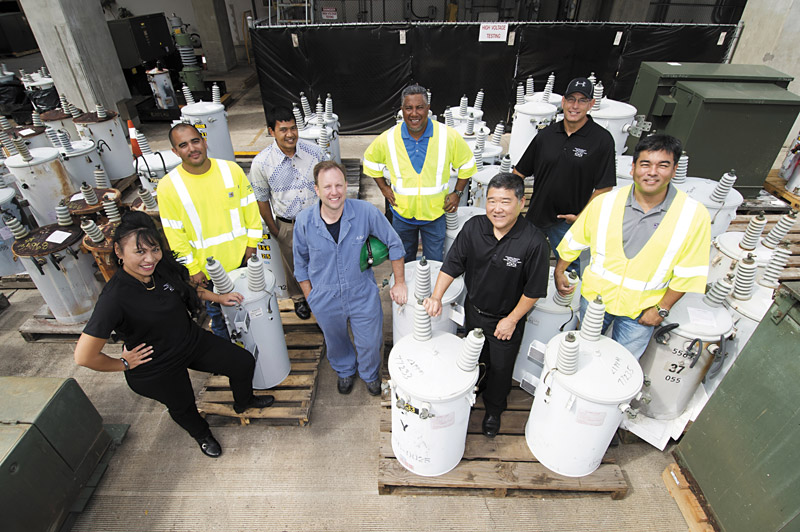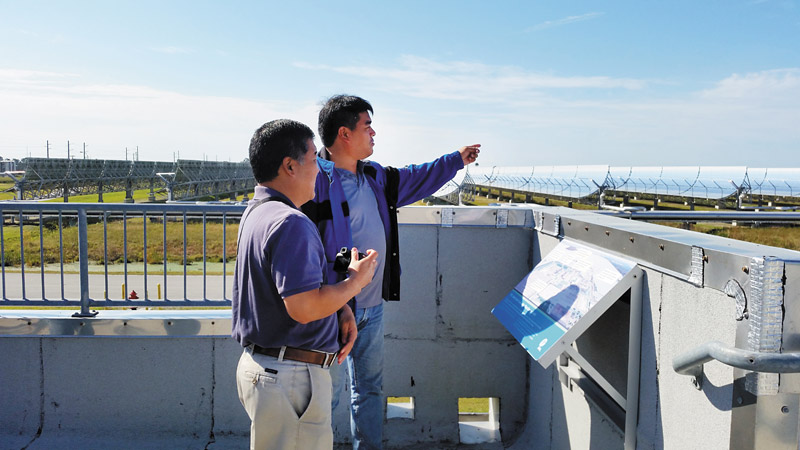Electric Exchange

These eight HECO employees visited NextERA in Florida (from left): Susanna Ontai, Jordan Arruda, Stuart Quel, Adam Carlson, Kirk Kamanu, Ryan Kadomoto, Troy Hill and Steven Minakami. PHOTO BY NATHALIE WALKER
In an exclusive interview, MidWeek sits down with eight HECO employees who visited NextEra in Florida to prepare for ‘integrating’ the two if their merger is approved
We think of Florida as sunny Miami Beach, the exotic Everglades and fun-filled Walt Disney World. But for 15 employees of Hawaiian Electric Company (HECO), Florida represents 45,000 megawatts of generating power, 4.8 million customer accounts, eight nuclear units at five plant sites generating 6,600 megawatts of emissions-free electricity, and utility rates 30 percent below the national average.
Unless you’re a power utility expert, this kind of data does not electrify your emotions. But for a HECO employee, it’s a charge.
This is a story about those employees who went to the Sunshine State in search of power plants, utility lines, futuristic energy centers and the truth.
What? No international cuisine at Epcot? No thrilling airboat ride through the swamp? No NASA networking at Cape Canaveral?
No, these scouts were on a mission-in-possible:
Possible merger of Hawaiian Electric Industries (HEI) with Florida-based NextEra Energy Inc., possible realignment and redefining of Hawaii’s largest utility, possible transformation of a 125-year-old isle legacy company to a Mainland-owned enterprise.
High Voltage
The subject has filled media and social networks since the merger announcement in December 2014. Currently undergoing Public Utilities Commission (PUC) review and approval, there’s no telling how this highly publicized and politicized matter will end up.
PUC has until June 3, merger expiration date, to make a decision. The meter is ticking.
As deliberations take place, it’s business as usual at HECO, where the focus is on customer service and generating 3,017 megawatts of electricity to 457,800 residents on Oahu, Maui, Molokai, Lanai and Hawaii island. (Kauai has an independent electricity co-op.)
The acquisition is likened to a small power generator connecting to a mega power grid to spark benefits to its stakeholders, including 24,000 shareholders in Hawaii.
Is the attraction of a modern, tech-savvy network like NextEra worthy of all the political and public debate as well as media thwarting HECO is going through?
Observers say it is because Hawaii’s energy future is at stake.
No doubt there are currents of concern among HECO’s 2,700 employees, too.
How do they feel about combining the two companies, and how do they see re-tooling a utility for the next generation of power users?

Ryan Kadomoto (left) and Steven Minakami look out at the more than 190,000 solar thermal mirrors that are capable of producing 75 MW of energy at FPL’s Martin Next Generation Solar Energy Center in Florida
MARI CARDINES PHOTO
We asked eight of the 15 employees who made the fact-finding trip to Florida in an exclusive MidWeek interview. It was illuminating.
They admit it isn’t easy being on the sidelines while your employer is the headline du jour and the subject of spirited debate from lowering rates to raising expectations for renewable energy.
“I get questions from customers all the time,” says Steven Minakami, junior customer planner in HECO’s customer service department. “Is it a good deal? We don’t have control over the transaction, but we can give perspective. They (NextEra) have a lot of good things you don’t realize until you take the time to become more aware.”
Being “more aware” is exactly what the integration officers of HECO and NextEra hoped to achieve in planning a four-day visit of frontline employees in March to NextEra Energy and its principal subsidiary, Florida Power & Light (FPL).
No matter where your alliance is in this matter, the eyewitness accounts of these employees add some perspective.
“This is not about employees being cheerleaders for the merger,” declares Shelee Kimura, HECO vice president of corporate planning and business development. “The idea for the trip came from an employee in a company talk-story session, and no customer dollars were used for the trip.”
She continues, “If corporate culture alignment is not addressed, it can trump any great planning done on a technical or logistical basis.”
Kimura and Steve Mc-Menamin, HECO senior vice president and chief information officer, lead the Hawaii integration effort.
Marlene Santos, NextEra chief integration officer and FPL vice president-customer service, coordinates the Florida program.
Santos adds, “We are tasked with ensuring that Day One of the merger goes flawlessly, which means addressing everything from financial reporting to basic human resource functions even before the transaction closes.”
Circuit Breaker
Up to 85 percent of mergers and acquisitions fail because of problems in the integration of employees and the management of culture issues, according to Corporate Leadership Council.
The effect of a merger on employee performance, productivity and attitude can range from optimism and excitement to uncertainty and resentment.
So what was the outcome of the employee trip and how are they using the knowledge and experience to address questions from co-workers?
Let’s switch on the dialogue from eight HECO workers.
Jordan Arruda, lineman at Maui Electric, now realizes that workers don’t differ much from place to place. He says, “I went on the trip with an open mind. I was excited to see how the big boys play on the Mainland.”
The Haiku resident, who has worked at Maui Electric for nine years, hung out with two senior linemen at the FPL service yard. After a while, he noticed the workers laughing at a group text warning them not to “look the Hawaiians in the eyes or they will eat you.”
“Linemen are linemen no matter where they are,” he says of their good-natured teasing. “I was ready for their harassing. But they would fit in at Hawaii, and I could have jumped into one of their boats to go fishing. They’re just like us.”
Adam Carlson, control operator at HECO-Waiau, concurs.
“My biggest takeaway is that we have more similarities than differences,” he says. “They are bigger and have more resources, but utilities everywhere have the same problems that need solutions.”
The Ewa Beach resident, who has worked for HECO for 11-plus years, was impressed with FPL’s Fleet Performance Diagnostic Center that monitors NextEra Energy’s power generation assets around the world with nearly 300 engineers.
“They track vibrations, temperatures and 2 million data points through smart grid technology, and predictive analytics to deliver real-time data that quickly identifies and locates potential causes of outages.
“For us to develop a department like that would cost us so much money, as opposed to just plugging into their system,” Carlson suggests. “They have five Ph.D.s who just work on algorithms that give them proprietary data.”
Cross Current
No doubt seeing advanced technology like this was like being a kid in a candy store.
Troy Hill, working foreman, Hawaii Electric Light on Hawaii island, points out, “The utility business is definitely changing. But we do stuff here that they don’t do over there — photovoltaic integration into the system, for instance. It’s comforting to know that we have a lot of experience and good people here that interest NextEra.
“For our customers, it’s about affordable and renewable power,” he adds. “This is especially critical on the Neighbor Islands, where distance is great and resources are limited.”
Ryan Kadomoto, systems engineer for five years with HECO, peered into the future at Florida.
“NextEra could give us a jump start and big leap forward on realizing our energy goals. They’re already doing things in Florida that we’re just talking about in Hawaii. New power technology will
help us be proactive rather than reactive to customer needs.”
But best practices flow both ways. The Kaimuki resident also saw aspects of Florida’s power operations that lag behind some of Hawaii’s leading and nationally recognized clean energy initiatives.
Kirk Kamanu, construction and maintenance operations supervisor, was the veteran HECO representative with 25 years on the line.
“I joined HECO in 1991 and worked my way up the ranks to become a supervisor,” says the Waimanalo resident. “Today I supervise more than 60 linemen, whose questions range from job security to corporate culture.
“We’re merging with a Mainland company with a different host culture,” he reflects.
“We have a unique culture in Hawaii that’s family-based, ohana-styled. When I shared with my fellow line-men that the Florida workers are the same tight-knit group that works together like we do, it took the edge off.
“I guess there’s credibility when it comes from a peer,” he observes.
“What I saw in Florida is a company that is innovative, forward thinking with technology that is lightyears ahead of what we have here. We have a state energy goal to be 100 percent renewable by 2045,” Kamanu reminds us.
“We must reach that goal with or without NextEra. I’ve got children, and we need to plan for the next generation of power users.”
Stormy Whether
Minakami, the newest HECO team member with two years and eight months on the job in customer installation service, lived and worked in Florida for 13 years prior to returning to the isles.
“Outages are common occurrences on Oahu,” he observes, “but they are rare in Florida. I’ve been through major hurricanes in Florida, the worst being Wilma in 2005 that spawned eight tornadoes and killed 35 people.
“During recent hurricane threats, Hawaii was grossly ill prepared. When power goes out, your lifeline ends. Storm preparation is so important. We need a wake up call so we don’t become victims of our own ill-preparedness,” he declares.
“Imagine having a power diagnostic system that can predict months ahead when a customer might lose service,” he suggests. “It’s like having the fire department come to your house and help you prevent a blaze before it occurs.”
Susanna Ontai, HECO energy contract analyst, says, “My co-workers are both excited and uneasy to see changes come. Relationships are important in Hawaii, and I wanted to know if Florida’s frontline employees feel valued and appreciated.
“People are concerned about change,” the Kapolei resident states. “But change is inevitable, merger or not.
“We saw the next decade of power utility in Florida where they have learned many lessons and could save us the heartache of reinventing the wheel. We could use their experience, knowledge and technology to make improvements.”
In group dynamics, there is always a “quiet one” who is reserved and understated. He doesn’t blurt out answers spontaneously because his mental wheels must turn before he engages his mouth.
That describes thoughtful and analytical Stuart Quel, HECO senior supervising engineer. When asked what the merger means to him, the Makaha resident sums it up this way:
“For me, the key message is opportunity. This is an opportunity for us to get better. It means taking a local company that’s been in operation for more than 100 years and using all the good things that NextEra can offer to Hawaii’s energy future.
“People are cynical because the forms of power generation are changing, and it will take a mix of technologies to achieve our goals. We have a vested interest in that future, with or without NextEra. The security and stability of our jobs depend on it.”
Or as the Peanuts character Linus puts it: “There’s not a heavier burden than a great potential.”
Last one out, turn off the lights.





